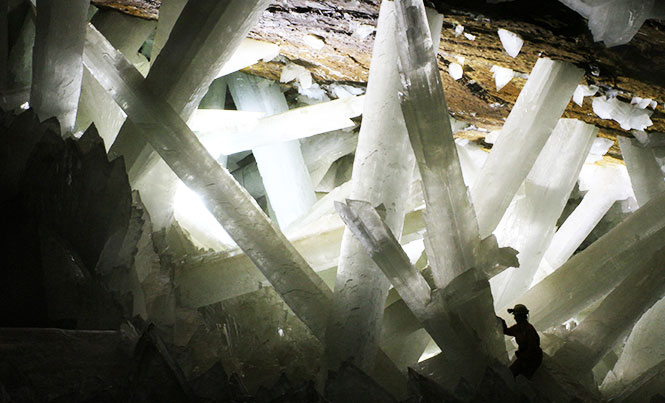The Crystal Caves of Chihuahua
In 2000, a couple of miners discovered unique crystalline formations in the underground cavities of northernmost Mexico

In the northern Mexican state of Chihuahua, nearly 1,000 feet below the desert floor, a discovery was made by two mining brothers. Chihuahua, which borders New Mexico and Texas, is home to the Cave of the Crystals. This cave system is unique due to its giant, glistening crystals.
It wasn’t until 2000, while drilling through the Naica fault and excavating a new tunnel for the mining company the magnificent Cave of Crystals, a horseshoe-shaped cavity was discovered. Its floor and ceiling covered with perfectly faceted crystalline beams, up to 11 meters long (36 feet).
 Jutting from all four corners, making you feel like Superman amidst the Planet Krypton, these pillars flawlessly refract light like diamonds in the sky. At the same time two other smaller caverns were discovered: Queen’s Eye Cave and Candles Cave.
Jutting from all four corners, making you feel like Superman amidst the Planet Krypton, these pillars flawlessly refract light like diamonds in the sky. At the same time two other smaller caverns were discovered: Queen’s Eye Cave and Candles Cave.
It is estimated that these giant structures, formed when groundwater saturated in calcium sulphate filtered through the cave system, are upwards of 500,000 years old. The caves are accessible by scientists today thanks to a mining company’s pumping operations that keep them clear of water; but were they to stop the caves would again be submerged in water. The Naica Project is attempting to visually document the crystals before they are either submerged in water again or deteriorate due to their exposure to air.
A team of scientists specializing in cave minerals and led by the crystallographer Paolo Forti from the University of Bologna explored the cave in detail in 2006. Due to the extreme temperatures of the caves, 44°C (112°F), with 90 percent humidity, the scientists wore specially designed refrigerated suits with cold breathing systems. The suits had refrigeration tubes over the whole body, connected to a backpack holding a cold water and ice reservoir, weighing 20 kg. The cooling provided by melting ice was sufficient to provide approximately half an hour of autonomy.
The most recent cave found during a drilling project in 2009 is known as the Ice Palace. At 150 meters it is thankfully not flooded, but its crystal formations are much smaller, with small ‘cauliflower’ formations and fine, threadlike crystals.
Although silver, zinc and lead have also been found, it is the crystals that catch your eye and the tip of the crystal iceberg may still be waiting to be found.
Due to its location and extreme temperature, this natural wonder is not open to the public.







